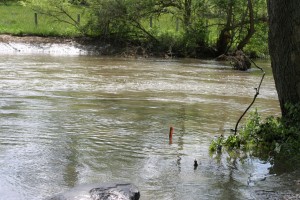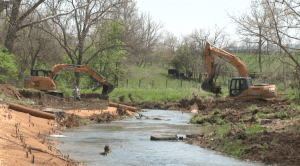
C Spout Run’s streambank restoration project was only days old when it got tested by the heavy rainfall in the Mid-Atlantic a few weeks ago. Spout Run, a tributary of the Shenandoah River, swelled from its typical flow rate of about 22 cubic feet per second (cfs) to 800 cfs; a 36-fold increase in volume.

That was disturbing news for partners in C Spout Run, a citizens’ effort to remove Spout Run from Virginia’s Impaired Waters list, supported by the National Fish and Wildlife Foundation’s Chesapeake Bay Stewardship Fund. Just one week before the rains, The Downstream Project had captured Seth Coffman of Trout Unlimited on video explaining how the giant earth-moving machines behind him were smoothing out Spout Run’s steep eroded banks. In doing so, they created a more natural floodplain that could allow flood waters to disperse across a wider area and deposit sediment along the way as flood flows diminish, rather than shoot through a narrow channel carrying all that sediment downstream. But would the new matting and scattered grass seed hold in such a powerful flow? Or would it all wash away in the storm, carrying more sediment with it? High sediment levels are one reason why Spout Run hasn’t met state or federal standards for fishing and swimming.
High bacteria levels are another, and the streambank restoration project is just one part of the larger C Spout Run initiative. Other parts include planting trees, monitoring aquatic life, reintroducing trout and more. The Downstream Project is capturing the entire C Spout Run project in a Website and Video journal, to help other communities learn from the Spout Run experience.
And so Downstream went back to the restoration site with Seth and Trout Unlimited stream restoration specialist James Fulcher this week to document their post-storm assessment. The consensus? The restoration project passed the test: The streambank held. In fact, it was a good thing that the project was completed before the storm. With the new streambank in place, the flood deposited about two inches of silt along the sides of the stream, rather than in it. See for yourself in the latest video, and watch Seth and James explain how this restoration helps rejuvenate surrounding soil while enhancing habitat for brook trout.
Through multimedia tools such as videos, blogging, photographs and more, The Downstream Project team can help other conservation efforts engage key audiences and attract new participants as well. Check out the C Spout Run video journal and consider integrating Downstream into your own project plans.
Note: This blog was originally posted on June 2 with updated video provided June 13 and June 23.
[nivoslider id=”2362″]

